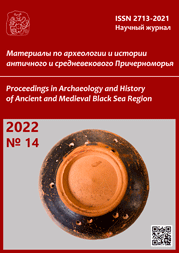Исследование древесины раннесредневековых артефактов из Крыма (по материалам могильника Чуфут-Кале)
Хylotomical study of Early Mediaeval wooden artifacts from Crimea (based on materials from the necropolis of Chufut-Kale)
Author(s): Anton A. Strokov, D.A. Kupriyanov, Galina A. KamelinaSubject(s): Archaeology, 6th to 12th Centuries
Published by: Нижневартовский государственный университет
Keywords: wood; xylotomical analysis; AMS-dating; radiocarbon; raw material; resources; Northern Black Sea region;
Summary/Abstract: Since 1957 until 1961, a rich sample of archaeological wood was accumulated during V.V. Kropotkin’s excavations near Bakhchysarai, at the burial ground of Chufut-Kale dated back to the late 5th — 9th centuries. The collection now reposes in the State Historical Museum. It was iron objects which preserve wood in most cases. Among these, knives and fragments of knives were especially numerous, with their blades and hafts displaying residual worked wood which probably left from scabbards and handles. The xylotomical analysis of the total of 52 samples from 19 burials was carried out to determine wood species. Fifty samples are turned to be identifiable. Most of these — 52% — consisted of poplar (aspen), and the rest were oak, maple, hornbeam, ash, linden, etc. Consequently, soft wood species, and above all poplar (aspen), predominated as, perhaps, most suitable raw materials. The wood species mentioned were neither invasive nor introduced in the Crimean flora. Ancient craftsmen are supposed to take their raw materials somewhere in the close proximity of the site, yet some wood species, such as pine, turpentine, and juniper, are known to grow elsewhere, so that their presence may suggest for active trading relations between Chufut-Kale and various regions of Crimea.
Journal: Материалы по археологии и истории античного и средневекового Причерноморья
- Issue Year: 2022
- Issue No: 14
- Page Range: 206-226
- Page Count: 21
- Language: Russian

